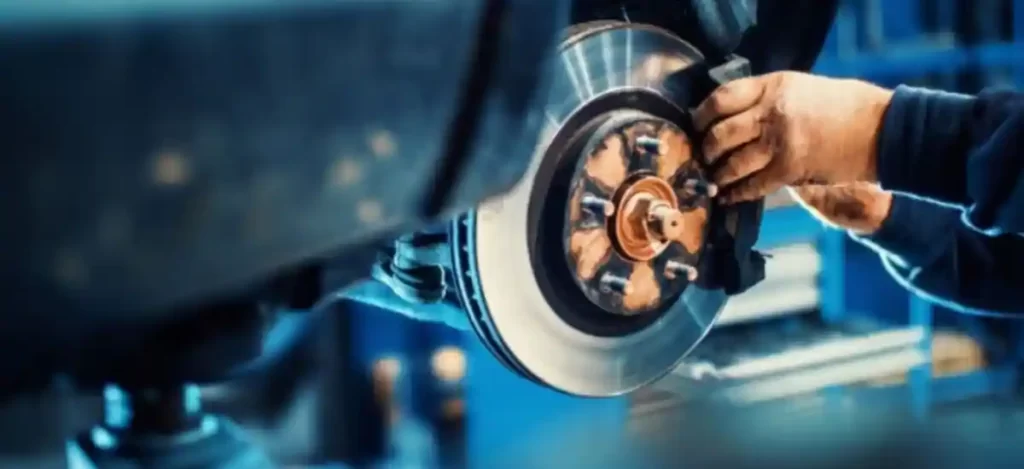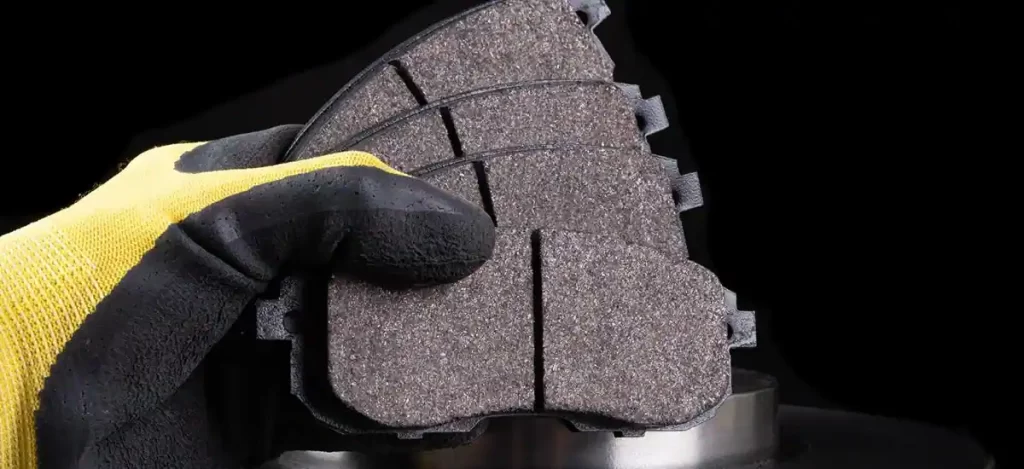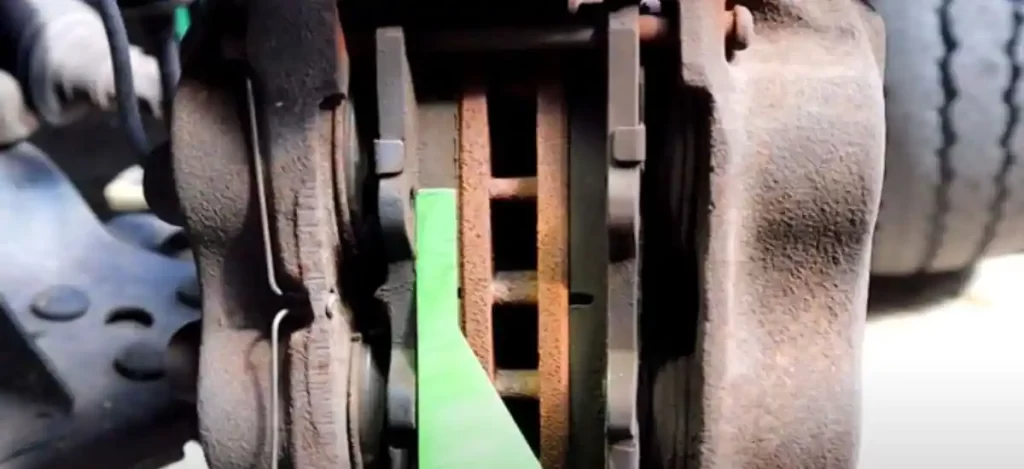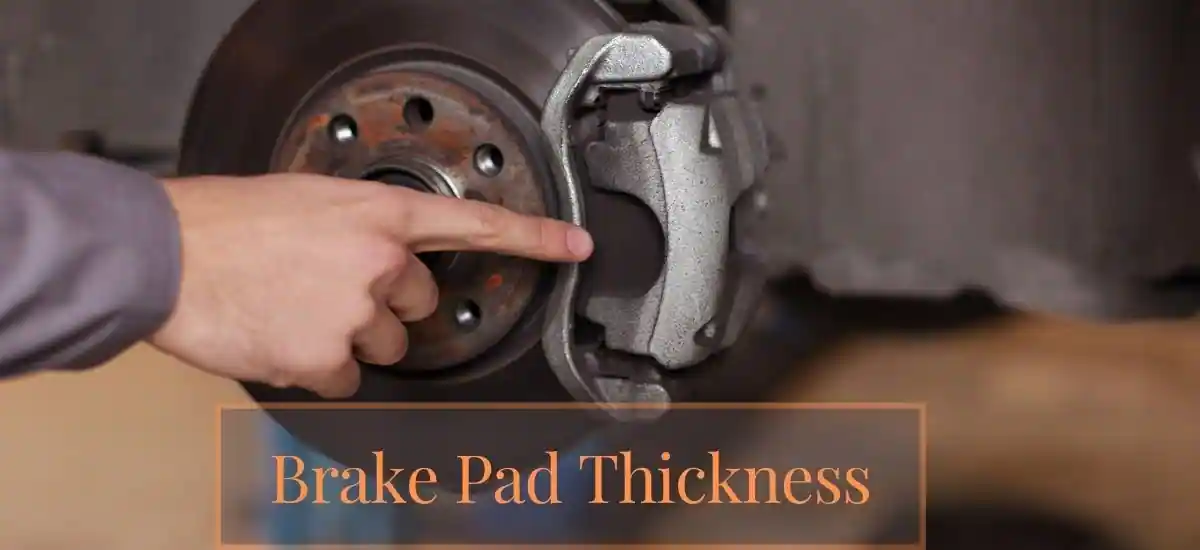For optimal performance, your brake pads should be thicker than 6.4 mm (1/4 inch). If it is thinner than this, think about replacing it right away.
The majority of auto technicians also agree that 3.2 mm (1/8 inch) is the absolute minimum brake pad thickness. If the brake pads are any thinner, you must replace them right once to prevent braking failure.
The amount of brake pad wear that develops is influenced by your car, your driving habits, and the state of the roads.
For instance, if commuter traffic is often congested and entails frequent starting and stopping, you’ll likely use your brake pedal more frequently.
What Are Brake Pads?

The components of a car’s braking system that actually absorb the majority of the frictional force required to stop the vehicle are called brake pads. The brake pedal in a disc braking system engages a hydraulic line, which forces the calipers against the car’s tire rotors.
In order to absorb energy and heat and subsequently offer adequate traction to stop the automobile, pads are positioned between the calipers and the rotors. An effective comparison for understanding disc brakes is a bicycle with 10 speeds. The handgrip under the rider’s hand resembles a car’s brake pedal.
Two caliper-like, hinged components are pulled together by wires when the rider tightens this grip. Two rubber sections instead of the calipers themselves make contact with the tire’s rim. These rubber shoes perform similarly to brake pads in automobiles.
The tire’s iron rim functions as a rotor in essence. The key to stopping with a disc braking system is the friction between the pads and the rotor. However, with time, the brake pads of a vehicle and the rubber shoes of a bicycle will deteriorate and seriously jeopardize the safety of the driver. Initially, asbestos and carbon were used to make brake pads, which were then kept together by a powerful glue.
The US government subsequently outlawed the use of asbestos, although certain non-metallic or organic varieties are still available. However, only vehicles made for organic pads may utilize them. Asbestos has been replaced with Kevlar, the same substance used in bulletproof vests, in non-metallic brake pads.
What Is The Minimum And Recommended Brake Pad Thickness?
From one application to the next and from one manufacturer to the next, brake pad quality and size may vary. However, brand-new front brake pads have a minimum thickness of around 12 mm. For your automobile, anything less is not recommended.
Rear brake pads, on the other hand, have a thickness range of 8 to 10 mm when brand-new. The reason for this is that you don’t need a lot of braking power at the back, and some cars’ rear brakes are drums since they don’t see the same amounts of stress as the brakes up front.
The most important thing for you to comprehend is how to correctly check the thickness of your brake pads. You’ll know when to change your brake pads and be able to drive securely.
What Are The Symptoms Of Thin Brake Pads?

1. There is a screeching sound.
Imagine yourself driving down the road with the radio off and the windows down. There is a subtle scraping, screeching, or buzzing sound in the otherwise silent environment.
2. A clicking sound is audible.
The brake pads in certain autos slide into a unique retaining mechanism with ease. They are stabilized by other vehicles using pins, nuts, or clips. In any case, the purpose of these designs is to prevent the brake pads from swaying.
They will start to rattle if they somehow get loosened (perhaps after some of the supporting hardware is destroyed). As a consequence, whenever the brake pedal is pressed or released, a clicking noise is heard.
3. It takes longer than it used to stop the automobile.
“Brake fade” is the term given to this issue. The majority of the time, it’s a direct consequence of deliberately applying the brakes over a long distance without fully stopping the vehicle. Such a move may sometimes be required, especially while traveling down a winding route or down a slope.
4. When you stop, the nose of your automobile pushes to one side.
The brake pads on your car won’t constantly deteriorate at the same pace. On occasion, individuals on one side may thin down more quickly than those on the opposing side. If this happens, using the brake may cause the vehicle to veer slightly to the left or right.
How Do Brake Pads Work?
Using your car’s brakes efficiently involves much more than just pounding on the pedal when a squirrel leaps out in front of you. Numerous components make up the braking systems of automobiles, trucks, and motorbikes, which convert the driver’s input into the physical force required to stop the vehicle. The brake pads on your car are one of those braking components.
Because brake rotors those flat, gleaming discs that you can sometimes see just behind the wheels of certain vehicles—are touched by braking pads, they are an essential component of the brake system.
The brake rotor experiences pressure and friction, which slows and stops the wheel. When the wheels cease rotating, the car also comes to a halt. Although brake pads’ function as braking components is rather straightforward, the brake pads themselves are anything but.
Every time you slow down or stop, the weight of a standard car or truck plus how quickly a vehicle’s wheels spin put a tremendous amount of stress on the brake pads.
Consider this: Would you wish to grasp and maintain a grip on a hefty metal disc that was spinning really quickly? It seems to be a thankless task to steadily squeeze the disc until the car comes to a stop, yet brake pads do it again and over again for tens of thousands of kilometers with no complaints.
How Do You Measure Brake Pad Thickness?

Block the wheels, use the parking brake, and park on a level surface.
Front lug nuts should be loosened.
Set the vehicle up on jack stands and jack up the front end. Taking off the front wheels The pad thickness may often be seen through the edge of the caliper when the wheel is off.
It may be presumed that the second one is worn at least as much, if not more if you can only measure or see one.
Since it is just as simple to swap out the pads as it is to rotate the caliper and take a precise measurement, there is no need for a perfect measurement.
Lower the automobile to the ground after replacing the wheels.
FAQs
1. How Much Does Brake Pad Replacement Cost?
An axle’s worth of brake pad replacement typically costs $150, and this sum includes both components and labor.
2. At what thickness should brake pads be replaced?
However, the majority of manufacturers and experts would concur that you should definitely change your brake pads whenever they have worn down to 3mm.
3. What’s The Ideal Brake Pad Thickness?
The thickness of brand-new front brake pads should be at least 12 mm. For your automobile, anything less is not recommended. Rear brake pads, on the other hand, have a thickness range of 8 to 10 mm when brand-new.
Check More:

